Set Review ➟ LEGO® 80039 The Heavenly Realms

The set comes in a large box and unlike many LEGO sets this box is actually pretty full instead of being half empty. Nested inside the main box is a second box containing parts bags 1 through 7 and a poly sleeve containing two manuals, mylar clouds, and stickers. Parts bags 8 through 17 are in the main box along with four loose 65803 16x16 white technics bricks. Conveniently the inner box contents, along with two of the loose 16 x 16 bricks, match up with the assembly instructions in the first manual.
Minifigures
The set offers eight minifigures. There are three versions of Monkey King, one version appropriate for each of the three scenes from the legend depicted: garden, crucible, and palace. Garden Monkey King has no tail. The head for Garden Monkey King and Crucible Monkey King is the same, one side with a golden eye and the other without, although according to the legend Monkey King doesn’t get his truth-seeing golden eyes until the end of the crucible episode which follows the garden episode. All heads in the set have two faces.
Following the Monkey Kings are the Heaven Fairy who hangs out in the peach garden, Taishang Laojun with the crucible, Erlang with the palace, Nezha…what happened to Nezha? Nezha has full minifigure legs in the Nezha’s Fire Ring set but here he has the short legs. No doubt the short legs are what causes Nezha’s defeat at the hand of Monkey King when they battle in heaven. But I digress. Last is Monkey Kid who apparently is a tourist and the same figure as in the 80036 City of Lanterns set. As of this writing all figures other than Monkey Kid are exclusive to this set.


The Build
The assembled set has a large footprint. In the open configuration it is 20in/51cm wide by 15.5in/39cm deep. In the closed configuration it is 16.25in/2cm wide x 13in/43cm deep. The height is 15in/38cm tall. I found assembly to be enjoyable. With over 2400 parts it took a few hours to build and did not at all suffer from the monotony of, say, the set 10276 Colosseum build. There is a bit of Technic structural assembly under the main temple, some Technic lever assembly in the cloud/open/close mechanism, one wall of the garden is assembled and attached upside down, and there is a good variety of assembly techniques involving clips, hinges, turntables, pins, and bars so the build is never boring.
Opening and closing the set
The set is comprised of four main modules: the gate with path, the garden, the crucible (LEGO calls it “the furnace”), and the palace. The configuration is the palace in the back with the garden on the front left, the path and gate in the front center, and the crucible on the front right. Each of the garden and crucible sections is about half the width of the palace section.
A Technic mechanism connects the four sections with the gate and path acting as a lever. Pushing the gate/path section toward the temple when in closed position will cause the garden and crucible sections to pivot out and away from the path and cause a sheet plastic cloud on either side of the path to slide away from center. Pulling the gate/path away from the temple will close the display.

Set closed.
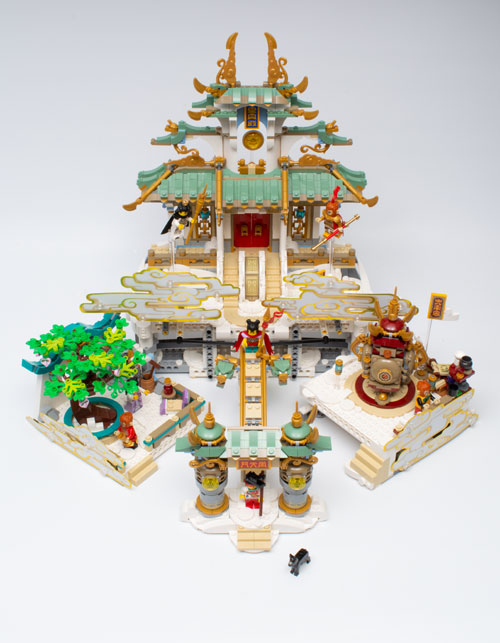
Set open.
The push-pull lever works mostly okay, but occasionally gets stuck; moving the garden and crucible sections directly works to resolve the issue. While pushing the path causes the clouds in front of the temple to move, pulling the path doesn’t always cause them to retract and they will need to be repositioned by hand. Also the clouds do not part to their fullest extent when using the push mechanism. To achieve full cloud parting manual intervention is again required.
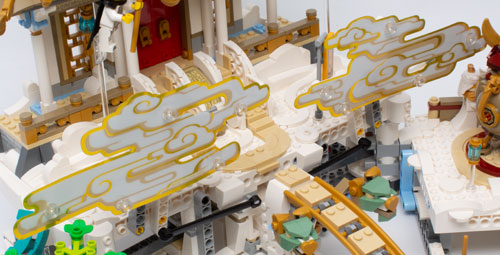
The clouds open when the gate section gets pushed back toward the palace section.
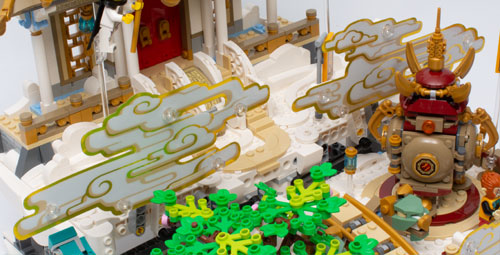
Unfortunately the clouds don’t always retract when the gate pulls forward.
Near the top of the path on there is a dragon head ornament assembly and its positioning is secured by a single stud. I found in practice that this stud eventually separated from the companion anti-stud and the dragon heads slumped to the side. If this happens then the dragon heads interfere with the closing of the side modules.
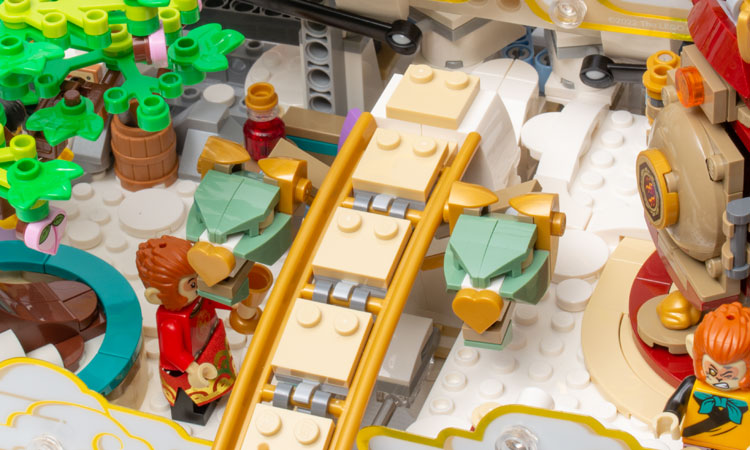
When closed, the side modules tuck under the dragon heads.
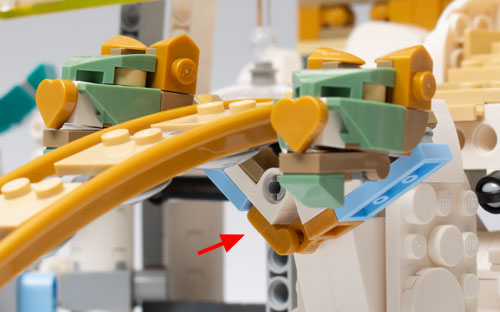
With repeated pushes and pulls this stud works itself out…

…and the dragon heads slump down.
The Palace Section
The palace is the largest section and very ornate, as is the entire model. The palace itself is primarily just a facade, though. There is a lower balcony where minifigures can be positioned, but no moveable elements other than the doors in the section. It’s basically a movie set which looks like something but really isn’t something.
In front of the palace is a courtyard with two sets of steps leading up to the palace doors. The red doors do open, but they open onto nothing. There is insufficient space behind the doors to position a minifigure–the doors swing into the building–and opening the doors would knock off anything positioned behind them.
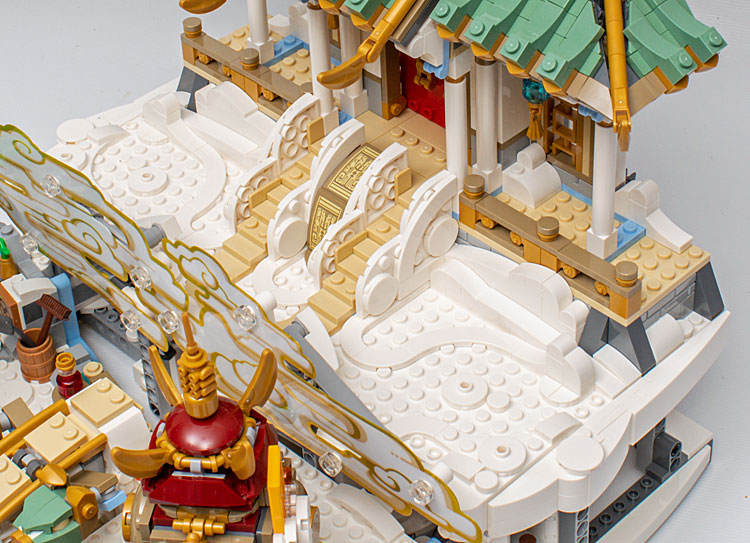
The courtyard floor has a lot of superficial greebling which affects minifigure placement. There is an obvious spot on either side of the base to accommodate the invisible flight posts to which Monkie King and Erlang get attached for their battle. Unfortunately the flight posts aren’t able to be positioned nearer one another and the epic battle is more akin to a slap fight at twenty paces. Or maybe the two hurl harsh words at one another.
The palace is built on an elevated platform underneath which the open/close mechanicals reside. On either side of the front is a sheet plastic cloud. The clouds are relatively tall and obscure the courtyard to quite a degree in both open and closed configuration. This is another instance of LEGO going to the bother of making some portion of the model visually interesting then hiding it behind additional build elements. The clouds further interfere with access to the courtyard which effectively hinders playability.

View of the courtyard with the clouds closed. Much of the lower portion of the model is obscured.

When the clouds part the windows are obscured but the steps are revealed.
While there is some pretty epic beauty with the palace facade, the same cannot be said for the back, sides, and the underneath of the section. From any angle the undersection is pretty much similar to viewing the lower decks of the Nostromo as Technic elements and everything else is exposed. The section uses rubber tires on posts, the same assembly we saw on the Monkey King Mech, to keep that section from moving when the set unfolds (the garden, crucible, and gate all use part 2654 boat studs on their undersides so they will slide).

The back side offers a couple clips for invisible stand storage, but that’s the highlight, if you can call that a highlight…and a single stickered tile which is likely an Easter Egg of some sort.

The undersection of the palace is like the lower decks of the Nostromo. Alien not included.
The Garden Section
The garden section is quite attractive with a large peach tree and a sculptural wall with a rounded opening. The limbs of the tree are easily bumped out of position and end up drooping. Their construction is a combination of robot arms and bicycle handles topped with large leaf pieces. The relatively heavy weight of the tops ends up being more than a match for one clip-and-bar connection to support firmly. There is detail on the wall that gets obscured by the tree.
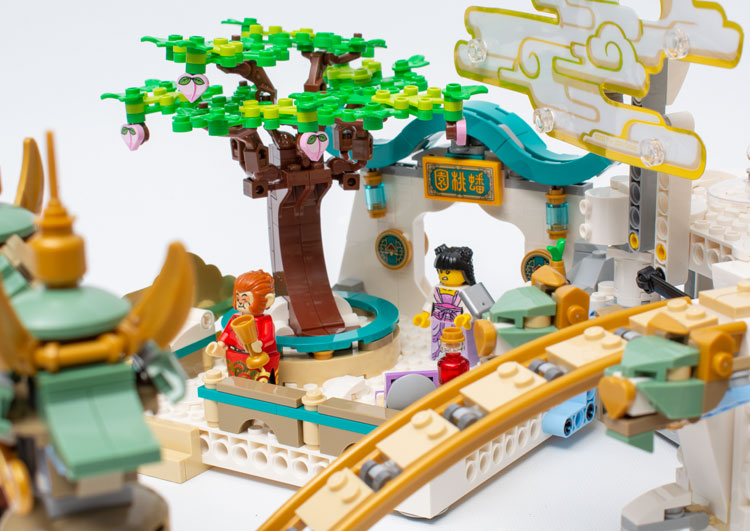
The lovely detail on the wall is obscured from other viewing angles.
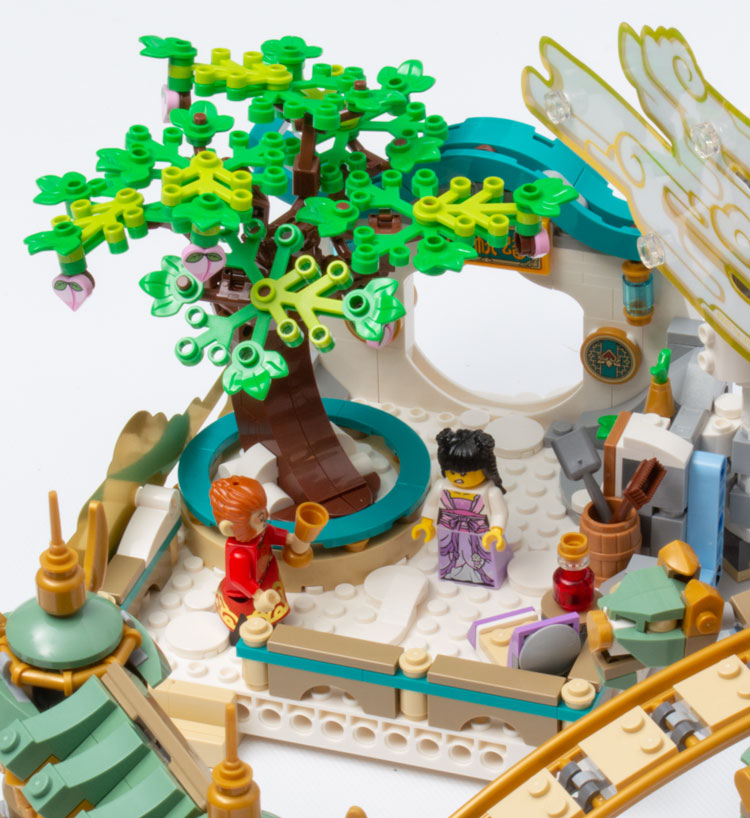
Oops, there goes a tree branch wilting again.
There appears to be some floor space where minifigures can be placed, but as with the floor of the courtyard there is some degree of greebling and access to the available space is frustrated by the tree, the cloud on the front, and the space’s interior position below the cloud on the palace section and beside the path. And while a chair is offered in the layout, neither Monkey King with his skirt or Heaven Fairy with her slope bottom can recline on the chair. Realistically, of all the minifigures in this set, only Erlang can recline in that chair without altering his assembly.
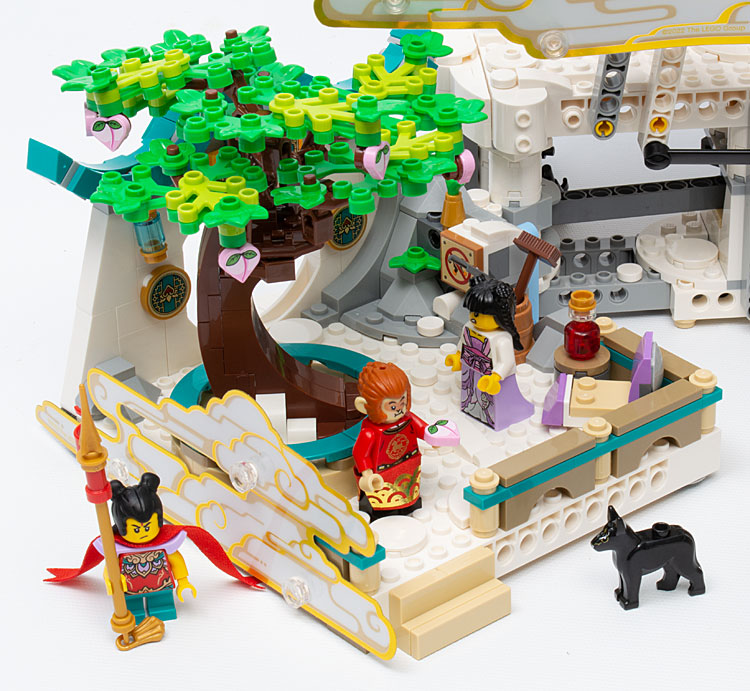
The Gate Section
This small section is primarily a decorative element and serves as a grab point for pushing and pulling the path-lever used to open and close the set.
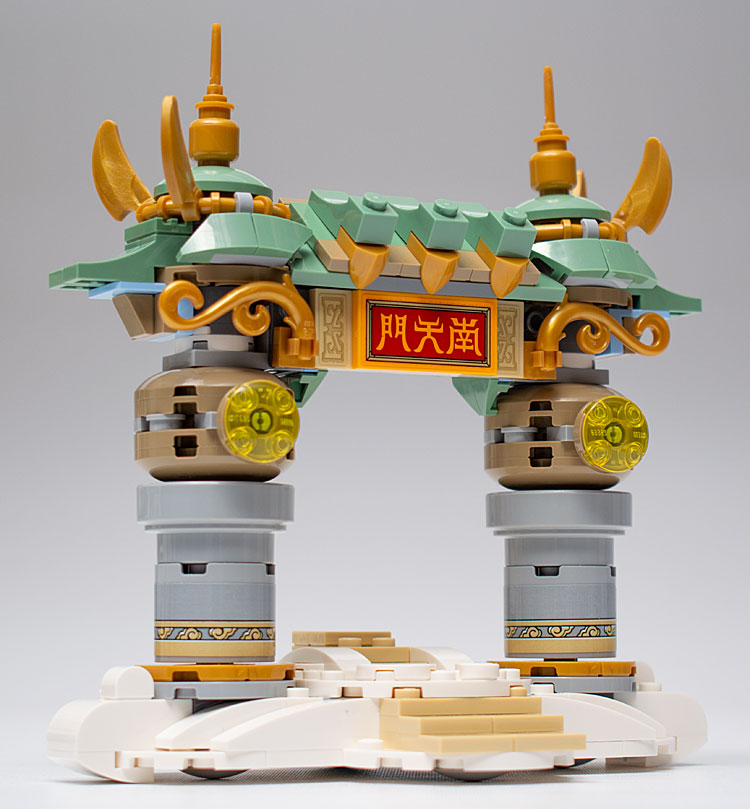
The Crucible Section
As with the garden section, the crucible section is a 16x16 stud area. An area of 10x10 studs in the center is allocated for the crucible itself, two sides have a wall on the outer studs, three studs deep is required against the back side to accommodate the slide-out cloud, and four studs are required for clearance of the dragon head when the module is folded against and under the path. This occupation of available space combined with decorative greebling, flag, and lanterns on what’s left of the floor space leaves precious little room to place a minifigure. Taishang Laojun uses a slope for legs and therefore requires a 2x2 stud space to be placed. Monkey King has a few more options for positioning than does Taishang Laojun as Monkey King only needs two studs for his feet, but both figures need arm space. If the set is in the open configuration then there are a few more options for figure positioning, but the figures will need to be moved away from the left and back areas to allow the set to close.
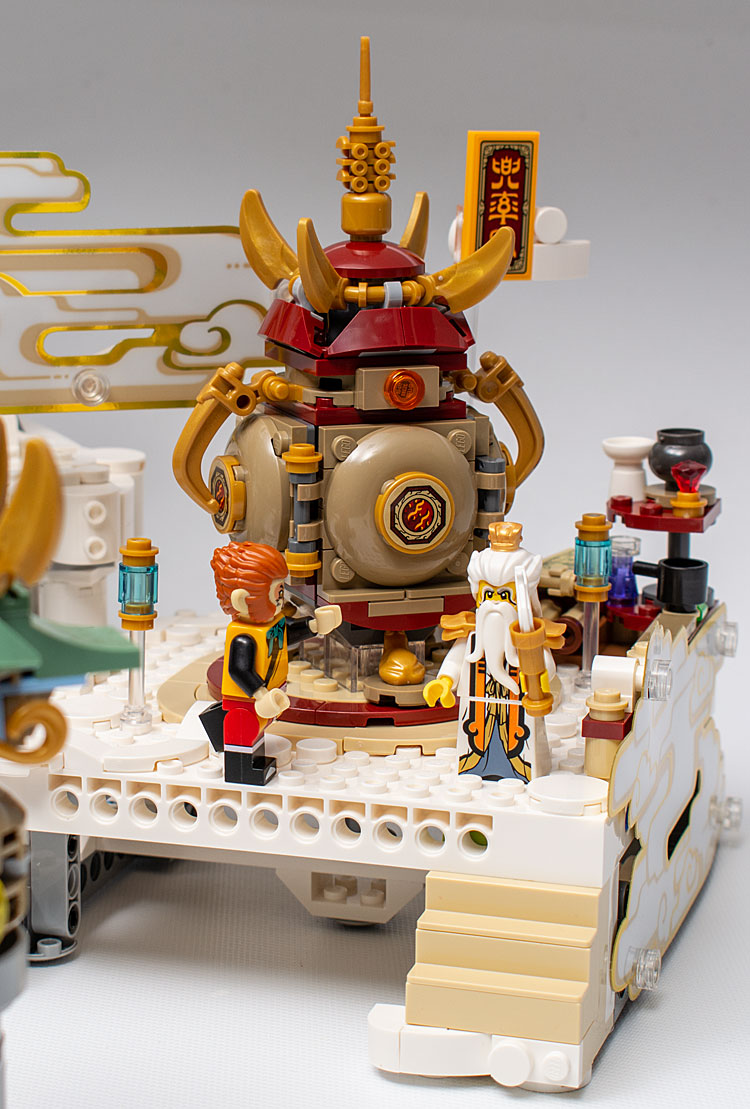
Though the crucible itself has a door and some interior space which looks like it would accommodate a minifigure, alas, no. Where with the bone cage in the 80034 Nezha’s Fire Ring set Monkey King could be fit inside the cage with some clever or awkward positioning of the figure, Monkey King minifigure doesn’t fit inside the crucible at all. Given the importance of the crucible in the Monkey King legend…where Monkey King survives 48 days in the crucible as the gods of heaven try to kill him…this is a bit disappointing. To be fair, Monkey King will fit in the crucible if his tail piece is removed and Monkey King is placed in a sitting position. It is also fair to say that is a disappointing solution.

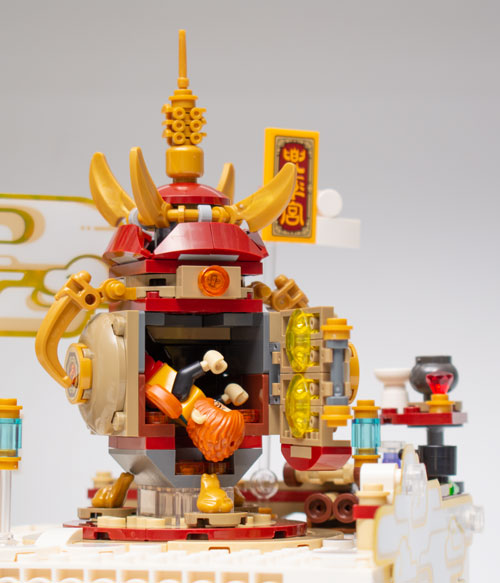
The spiky bit on the top of the crucible deserves a comment. While it is nice looking I cannot count how many times I inadvertently knocked the assembly off the top of the crucible while attempting to position some other element on the model. In the way it is, and all the time.
Play Value
Play value with this set is nearly non-existent. Once you get past the lever mechanism that opens the set, the doors on the main temple, and the door on the crucible there’s nothing else that’s really interactive. Dense construction and overlapping elements make access to potential play areas difficult. Play value may be somewhat improved by disassembling the sections from one another and removing the upper cloud mechanism from the build.
The Randolph T. Fielding Absolutely Administrivia Section
In the ongoing saga of LEGO part color nuances we have the usual selection of various pearl golds though this set’s selection is less varied than we get in some sets. The reddish brown parts in the set are redder than what I have seen before except for robot arms and frogs which are the more usual (slightly yellower) reddish brown. The dark red in the set tends towards the more orange side of the dark red range.
The transparent bright green, clear, light blue, and purple parts all fluoresce, as does Monkie Kid’s headband.
The 2x2 plate with underside pin is marked 48241 but appears identical to the last generation 2476 which it replaces.

Left to right: Light gray 2476 with locking fingers, dark gray 2476 with wide ring, white 2476 with narrow ring, white 48241.
The 2x2 brick with two side pins is marked 65541 and has a few variations from the earlier part number 30000 version of the brick: the pin holes on the 65541 are smaller and have a different shape than the 30000, the ribs inside the axle hole alternate thick and thin on the 65541 where they are uniform shape on the 30000, and the underside on the 65541 has a side reinforcement under the pins where the 30000 has a crossbar.
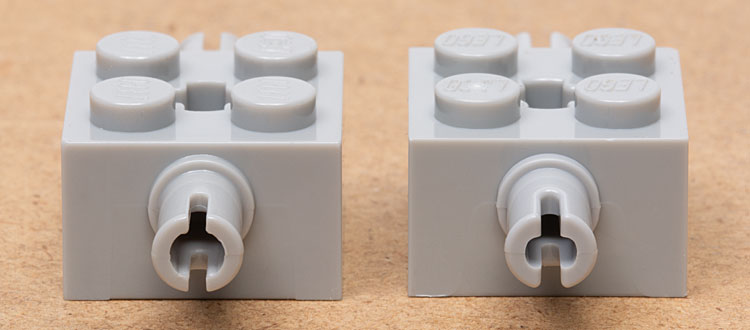
Sides. Left: part 30000; right: part 65514.

Tops. Left: part 30000; right: part 65514.
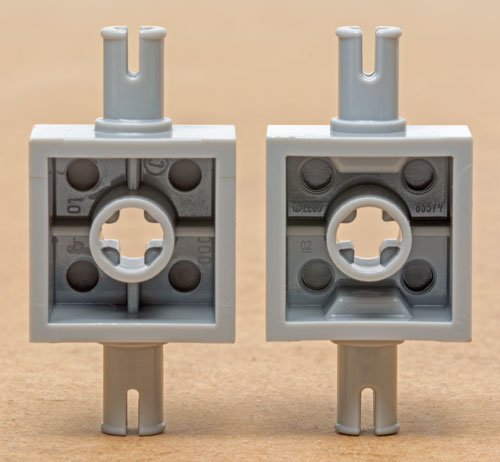
Bottoms. Left: part 30000; right: part 65514.
New to me are two technic 1L pin parts. There is a white 4274 instead of the usual blue or gray and a red 89678 with friction ridges. Longer pins include the 2L black 61332 friction pin, the 2L yellow 3676 frictionless pin (instead of the usual medium stone gray), the 3L medium stone gray 77765 frictionless pin with an open stop end that nests into a technic hole, and the 3L orange 65043 pin with bushing.
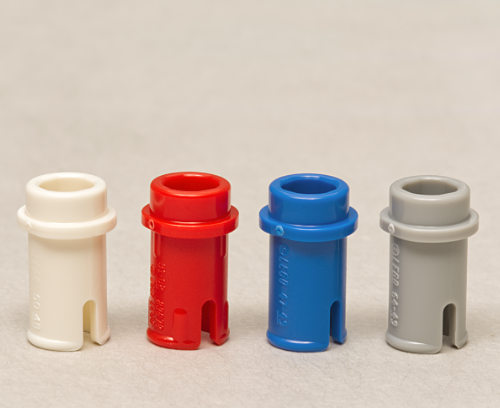

A cardboard sleeve labeled 6395807 contains four cloth pieces: a decorated red skirt, two red scarves, and a black cape.
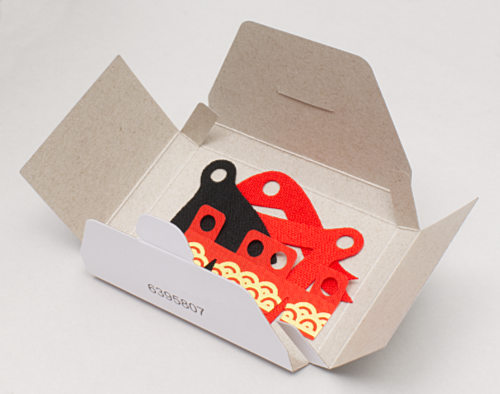
Summary
This is certainly an extremely ornate set. If you enjoy builds with variety, and you have a substantial display space available and intend the set as a display piece, then it may be just your thing. Play value is minimal and the lever mechanism is not exquisitely functional and may not stand up particularly well to repeated or aggressive handling. The dense but fragile construction of some elements interferes with play access to areas and may be prone to requiring ongoing attention.
Disclaimer
Thanks to LEGO for providing the set. Nobody influenced any opinion presented here, nor did anybody influence my decision to set it up and not play with it.
33552